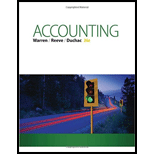
Concept explainers
Entries for materials cost flows in a
The Hershey Company manufactures chocolate confectionery products. The three largest raw materials are cocoa, sugar, and dehydrated milk. These raw materials first go into the Blending Department. The blended product is then sent to the Molding Department, where the bars of candy are formed. The candy is then sent to the Packing Department, where the bars are wrapped and boxed. The boxed candy is then sent to the distribution center, where it is eventually sold to food brokers and retailers.
Show the accounts debited and credited for each of the following business events:
a. Materials used by the Blending Department
b. Transfer of blended product to the Molding Department
c. Transfer of chocolate to the Packing Department
d. Transfer of boxed chocolate to the distribution center
e. Sale of boxed chocolate
Trending nowThis is a popular solution!

Chapter 20 Solutions
ACCOUNTING-W/CENGAGENOWV2 ACCESS
 Managerial AccountingAccountingISBN:9781337912020Author:Carl Warren, Ph.d. Cma William B. TaylerPublisher:South-Western College Pub
Managerial AccountingAccountingISBN:9781337912020Author:Carl Warren, Ph.d. Cma William B. TaylerPublisher:South-Western College Pub Financial And Managerial AccountingAccountingISBN:9781337902663Author:WARREN, Carl S.Publisher:Cengage Learning,
Financial And Managerial AccountingAccountingISBN:9781337902663Author:WARREN, Carl S.Publisher:Cengage Learning, Cornerstones of Cost Management (Cornerstones Ser...AccountingISBN:9781305970663Author:Don R. Hansen, Maryanne M. MowenPublisher:Cengage Learning
Cornerstones of Cost Management (Cornerstones Ser...AccountingISBN:9781305970663Author:Don R. Hansen, Maryanne M. MowenPublisher:Cengage Learning Managerial Accounting: The Cornerstone of Busines...AccountingISBN:9781337115773Author:Maryanne M. Mowen, Don R. Hansen, Dan L. HeitgerPublisher:Cengage Learning
Managerial Accounting: The Cornerstone of Busines...AccountingISBN:9781337115773Author:Maryanne M. Mowen, Don R. Hansen, Dan L. HeitgerPublisher:Cengage Learning



